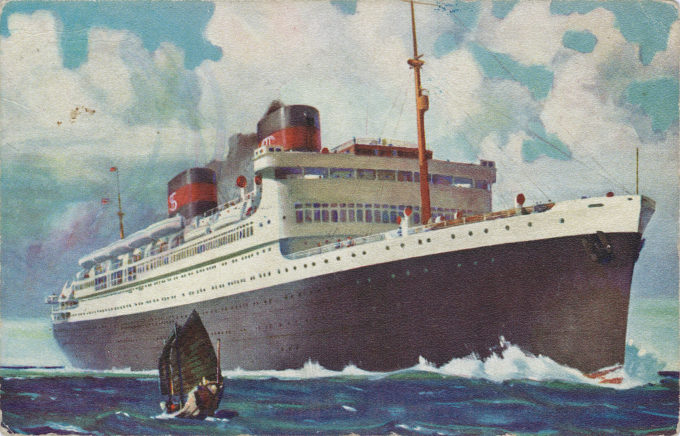
S.S. President Cleveland, Dollar Steamship Line, c. 1930. Not be confused with the post-Pacific War passenger-cargo liner of the same name operated by American President Lines. This first S.S. President Cleveland was originally constructed as Golden State for the United States Shipping Board (USSB), one of several planned World War I fast troop transports but which were converted before construction (because of the war’s end) into passenger-cargo vessels and first operated by Pacific Mail Steamship Co. It was sold by the USSB to the Dollar Steamship Line in 1925, with sailings every 14 days from San Francisco along a route dubbed “The Sunshine Belt to the Orient” via Honolulu, Japan, China, and the Philippines with sister ships President Lincoln, President Pierce, President Taft, and President Wilson.
The President Cleveland was transferred to the U.S. Navy on 19 August 1942, after which she was converted for use as a Navy transport and renamed Tasker H. Bliss (AP-42). AP-42 was part of Task Force 34, participating in the invasion of North Africa (Operation Torch), where she was attacked and sunk by a German U-boat off the Moroccan coast.
See also:
S.S. President Cleveland, American President Lines, c. 1960.
NYK Line (Nippon Yusen K.K.).
Departure by Steamship, Yokohama, c. 1930.
Surrender of the US & Philippine armies at Bataan, Philippines, April 9, 1942.
“Since 1899, San Francisco had been the primary port of dispatch for the U.S. ships headed to the Orient. Upon our arrival in July 1941, Shilhavy and I reported to the embarkation point at the Presidio. We were assigned quarters at the Hostess House and told that we would ship out four days later.
“… A few days later, Bob and I were among the twenty-five hundred servicemen who boarded the S.S. President Cleveland bound for the Philippines. The President Cleveland was a commercial cruise ship. Owned by the Dollar Line, it normally plied the Pacific tourist trade but had been called into service to ferry military personnel overseas.
“Fortunately, we were the first group of troops to be transported on it. The crew, still accustomed to caring for civilian passengers, treated the officers like paying guests. The first-class accommodations were fine, and we officers ate in the sumptuous first-class dining room, which served some of the best food I have ever eaten. I sampled the whole menu before the voyage was over, including dishes I had never heard of, and was so pleased by the ship’s bill of fare that I sent copies of it to my mom back home.
“Somehow, another young officer and I were assigned to one of the new on-board staterooms. The spacious cabin was very clean and decorated in bright, inviting colors. We had comfortable twin beds, a portal, and a private bath. My roomy and I knew immediately that someone had made a mistake, for our lodgings were stellar compared to those of other officers. The old army adage ‘RHIP’ – Rank Has Its Privileges – was in effect, and had any majors or colonels found out where we were staying, we would have lost that fine setup immediately.
“… Throughout the voyage I feared losing that prime cabin. But luckily, no one discovered the arrangement. As we sailed toward the Philippines, I became convinced that my fortunes were on the rise.”
– Bataan: A Survivor’s Story, by Lt. Gene Boyt with David L. Burch, 2004

